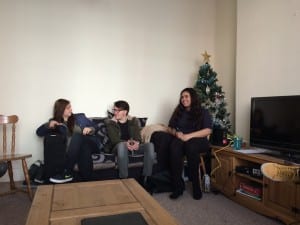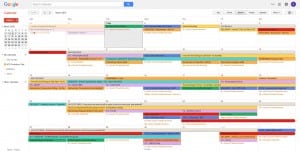(Outcomes – IN1, GR1, GR4, PER1)
In my capacity as the supervisor for OG Productions managing the film Descent, I’d solicited a list of ideas from the films director about the audio dimension within a week of agreeing the services we would be providing for the film. These were perfunctory in terms of specific links to the film, as would be expected as this stage since no script or storyboard had been completed, but were detailed in terms of reference points from other films. There was also a list of potential choices of diegetic source music tracks for a song playing from a radio at some point in the potential script, as a reference point. At first glance many of these were highly unlikely to be clearable in the context of the film as the film-makers were keeping their options open and requested we clear any material required for the soundtrack for use at film-festivals and for online use in portfolio. [IN1]
Upon arrival of a script and storyboard for Descent some weeks later, the audio team read through the script together in round-table fashion. I’d insisted on this process for OG Audio’s three longer films as it was obvious that our collaborative approach to work could very easily have translated into creative isolation for the supervisors responsible for the less ‘desirable’ films (for example, as some scripts appeared stronger than others, or because of genre preferences for the team) in the pre-production stages. In the case of Descent the ideas session gave rise to two different directions for music for the film, a minimalist approach from Matt and a much more aggressive underscore heavy idea from Alice though with plenty of crossover in terms of pallette and timbre between the two – I felt Alice’s choices were likely better for the film initially. Potential recurrent motifs and key scenes for audio were isolated and a scratch sound-plan with an overview of these ideas created. [IN1 + GR1 + GR4]
I was keen to solicit as much feedback as possible throughout the process of liason with the film group, so this plan was then cross-referenced with the director on a page by page basis at the set-recce and meeting pictured above, enabling me to tweak the plan more to their liking with almost everybody involved in the production present. For example, my preference for a relatively music heavy film was overturned as the director clearly preferred the subtler, more minimal approach to the music design as we described it, and as such I asked Matt to provide the score and music for the film. The meeting also yielded useful discussion on several overall balance issues within the sound design of the piece, such as how far we should be ‘borrowing’ from horror and thriller genres influencing the piece, tropes which were initially suggested by the original reference material provided by the director – It’s more thriller than horror, but only just. [GR4]
This session basically concluded formal pre-production on sound design, though some later correspondence and a second meeting were required to finalise specific elements and introduce a late addition to a scene suggested by the director in the form of an inner monologue which wasn’t present in the script, and which required specific recording time. This became one of several bones of contention in the sound design throughout, the other being scene 3’s radio music cue.
This process enabled me to piece together a master document of specific devices and the general audio arc drawn from the rough sound plan formed the basis for any team members working on the audio for the film in post, and which can be referred to by the director throughout the production.
However, no battle-plan survives contact with production and elements of this sound-script were dropped or changed in reference to the pictures as they arrived, and as the film moved into post I kept up the informal opportunities for the director to feedback on our work as they would often pop in for a listen whilst we were working on the piece. I concluded the feedback process with one more formal meet with the production team post picture-lock and after dialogue editing, foley and composition were complete but prior to mixing, roughly a week before deadline. I also requested our formal feedback at this time by way of the online feedback form I constructed for our use – The responses for Descent can be seen here – which was universally positive, best summed up in the response to an open question which I’ve lifted as a testimonial ‘…the team are extremely professional and skilled at what they do, they have the ability to transform a simple idea into something exceptional.’ [IN1]
Reflecting on this process, it was a good example of a creative collaboration between this audio team, and the director and her team. Ideas, approaches and plans were constantly being tabled, revised, filtered and discarded and the design input was spread roughly as evenly as the workload. The music decision was the main learning aspect for me, since having two composers working on the project in preproduction enabled me to present to vastly distinct approaches to the project in the early stages in some detail, thus prompting the director to a stronger vision of her musical requirements. [PER1]
———————- 900 Words
KEY POINTS –
Process of liasing with director about sound design requirements during pre and post production – Professional practice, Process Management,
- [IN1] To successfully manage the provision of service by the business for the film Descent with regard the assignment of resources, specialisms and working time, liason with the director, editor and producer on a practical and creative level, and communication of information on their needs and requirements for the piece, in order to appraise the efficacy of the collaborative approach to working on the piece – (Supervisor and Company Officer)
- [GR4] To conceive, compose, source and / or produce music to client specifications that synergistically supports the other components of their films.
Driving the collective creative process – Process Management
- [GR1] To professionally operate as a small to medium size company (or other recognisable business entity) in the audio production / post-production field might.
Reflection on learning – Individual reflection on learning and team role.
- [PER1] To develop a better understanding of the pros and cons of business structures, processes, regulations and agreements which might enable film audio producers to collaborate on multiple projects.





